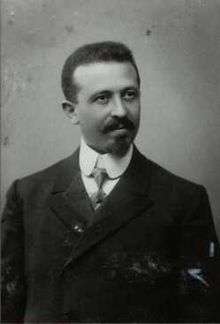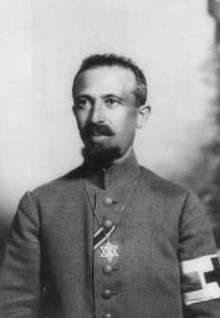Aaron Tänzer
Aaron Tänzer (German: Aron Tänzer, Hungarian: Tänzer Áron; also German: Arnold Tänzer; January 30, 1871 – February 26, 1937, Göppingen) was a rabbi in Austria and Germany, chaplain and author.
Aaron Tänzer | |
|---|---|
 Aaron Tänzer in 1907 | |
| Born | 30 January 1871 |
| Died | February 26, 1937 (aged 66) Göppingen, Württemberg, Germany |
| Resting place | Jewish Cemetery in Goeppingen |
| Nationality | Austrian |
| Alma mater | University of Berlin |
| Occupation | Rabbi |
| Known for | Organized soup kitchens for local population in Poland during WW I. |
| Military career | |
| Allegiance | |
| Service/ | Imperial German army |
| Rank | Feldrabbiner |
| Battles/wars | World War 1 |
| Awards | June 4, 1916 Iron Cross, Second Class. August 29, 1916 Württemburg Order Of Friedrich First Class With Swords . November 5, 1916, Franz-Joseph-Order with War Decoration, Knight. May 25, 1918, Hamburg Hanseatic Cross. November 1, 1918, Wound Badge In Black. |

Biography
He was born in Pressburg, Austria-Hungary (present day Bratislava, Slovakia).
He studied at the Pressburg Yeshiva, and studied Oriental philology and history at the University of Berlin (PhD 1895). In 1896, he was called to Hohenems as chief rabbi of Tyrol and Vorarlberg; and from 1904 to 1907 he was rabbi of Meran (Tyrol). From 1907 until his death, he served as rabbi of the Jewish community of Göppingen in Württemberg. His history of the Jews of Göppingen and nearby Jebenhausen is notable as a thorough documentation of a Jewish community from its beginnings.
In World War I, he served as a Feldrabbiner (Jewish chaplain) in the German army, primarily on the Eastern front. He looked after German and Austrian Jewish soldiers and took care of Jewish prisoners of war in POW camps like Doeberitz and Sedan.[1]
Works
- Die Religionsphilosophie Josef Albo's, Frankfort-on-the-Main, 1896
- Der Israelitische Friedhof in Hohenems, Vienna, 1901
- Judenthum und Entwickelungslehre, Berlin, 1903
- Geschichte der Juden in Tirol und Vorarlberg, vol. i, ib. 1903–4.
- Die Geschichte der Juden in Hohenems und im übrigen Vorarlberg (History of the Jews in Hohenems and all of Vorarlberg) 1905 [2]
- Die Geschichte der Juden in Jebenhausen und Göppingen. Nachdruck der Ausgabe 1927. Konrad, Weißenhorn 1988, ISBN 3-87437-274-X (Veröffentlichung des Stadtarchivs Göppingen. Band 23)
References

- "Archived copy" (PDF). Archived from the original (PDF) on 2011-07-25. Retrieved 2008-12-12.CS1 maint: archived copy as title (link)
- "Bartholomäus Schnell and Aron Tänzer | Jüdisches Museum Hohenems". www.jm-hohenems.at. Retrieved 2020-04-22.
External links
- Works by or about Aaron Tänzer at Internet Archive
- Guide to the Papers of Arnold Tänzer (1871-1937) at the Leo Baeck Institute, New York.